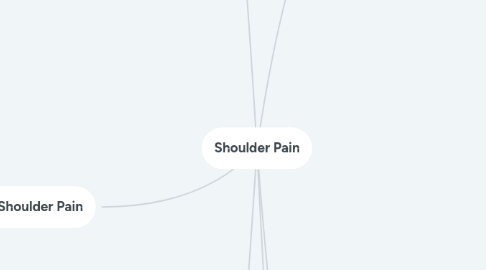
1. Traumatic Shoulder Pain
1.1. MOI:
1.1.1. Fall
1.1.2. Blunt Trauma
1.1.3. Sudden Loading/Eccentric Contractions
1.2. Humeral Fracture
1.2.1. Neers Scale
1.2.1.1. Dependent on anatomical locations
1.2.1.1.1. Greater tuberosity
1.2.1.1.2. Lesser Tuberosity
1.2.1.1.3. Humeral Head
1.2.1.1.4. Humeral Shaft
1.2.1.2. The lower the number, the lower the need for surgery
1.2.2. Non-Operative
1.2.2.1. Sling 4-6 weeks
1.2.2.2. Treatment
1.2.2.2.1. Early
1.2.2.2.2. Later
1.2.3. Operative
1.2.3.1. Be careful of bone/tissue healing and initiating care
1.2.3.2. Treatment
1.2.3.2.1. Early
1.2.3.2.2. Late
1.2.4. No difference in outcomes at 2 years with op v non-op or with early v. late mobilizations
1.3. GH Dislocations
1.3.1. GH and ANTERIOR Displacement
1.4. GH Seperation
1.4.1. AC and INFERIOR displacement
1.5. RTC Tear
1.5.1. see RTC
1.6. Tendon Tear
2. Atraumatic Shoulder Pain
2.1. Bony
2.1.1. GH OA
2.1.1.1. Typically have a prior injury
2.1.1.1.1. High association with RTC/Labral damage and GH OA
2.1.1.2. Risk Factors
2.1.1.2.1. Primary
2.1.1.2.2. Secondary
2.1.1.3. Signs/Symptoms
2.1.1.3.1. Crepitus
2.1.1.3.2. Pain in the morning that lessens with activity
2.1.1.3.3. Atrophy
2.1.1.3.4. Crepitus
2.1.1.3.5. Cartilage defects
2.1.2. AC degeneration
2.1.3. Bone Stress Injuries
2.2. Soft-Tissue
2.2.1. RTC
2.2.1.1. Signs
2.2.1.1.1. Shoulder rides high on x-rays
2.2.1.1.2. Variability in symptoms
2.2.1.1.3. Hirn-blowers sign
2.2.1.2. Know type of surgery
2.2.1.2.1. Through the subscapularis
2.2.1.3. Operative
2.2.1.3.1. Total Shoulder Arthroplasty
2.2.1.3.2. Reverst Total Shoulder Arthroplasty
2.2.1.4. Non-Operative
2.2.1.4.1. Medications
2.2.1.4.2. Corticosteroid Injections
2.2.1.4.3. Physical Therapy
2.2.2. Labral disorders
2.2.3. Frozen Shoulder
3. Post-Operative Conditions
3.1. Sub-acromial decompression
3.2. RTC repair
3.2.1. see RTC
3.3. Labral repair
3.4. Humeral ORIF
3.5. Shoulder Arthroplasty
3.5.1. Can be a standard or a reverse TSA, reverse is typically used with RTC complications,
3.5.1.1. TSA
3.5.1.1.1. Respect subscapularis guidelines if needed
3.5.1.1.2. Sling for first 3-8 weeks
3.5.1.1.3. Full Shoulder ROM by week 8
3.5.1.1.4. Start with isometrics and CKC and progress to progressive loading
3.5.1.2. RTSA
3.5.1.2.1. Benefit from pre-hab
3.5.1.2.2. Sling use 4-6 weeks
3.5.1.2.3. Full shoulder PROM and deltoid/scap resistance test by week 6
3.5.1.2.4. limitations of flexion and ER early
3.5.1.2.5. Perform PROM early, watch out for limits set by physician with AROM
3.5.1.2.6. isometrics early, progress to progressive loading weeks 6-8
3.5.1.2.7. Respect subscapularis guidelines if needed
3.5.2. Physical Therapy
3.5.2.1. Start with PROM
3.5.2.2. Progress to AROM/Strengthening
4. Non-MSK Disorders (Red Flags)
4.1. Tumor
4.1.1. Signs and Symptoms
4.1.1.1. Hx of cancer
4.1.1.2. Unexplained weight loss
4.1.1.3. Pain not caused by mechanical stress
4.1.1.4. No relief with rest
4.1.1.5. Night pain
4.1.1.6. Unexplained mass, swelling, or deformity
4.1.2. Examples
4.1.2.1. Osteosarcoma
4.1.2.1.1. Bone
4.1.2.2. Ewing Sarcoma
4.1.2.2.1. Children's adolescent bones
4.1.2.3. Chondrosarcoma
4.1.2.3.1. Connective Tissue
4.1.2.4. Pancoast Tumor
4.1.2.4.1. Upper lobe of the lung
4.2. Visceral Disorders
4.2.1. Cardiac
4.2.1.1. Intense angina
4.2.1.2. Pain
4.2.1.2.1. Chest
4.2.1.2.2. Left Arm
4.2.1.2.3. Left Neck
4.2.2. Peptic Ulcer
4.2.2.1. Irritation of the diaphragm (phrenic nerve of C3-C5) by gastric juices
4.2.2.2. Referral pattern
4.2.2.2.1. Right anterior/lateral border
4.2.3. Cholecystitis (Gall Bladder)
4.2.3.1. Accompanied with gall stones and abdominal pain
4.2.3.2. Referral pattern
4.2.3.2.1. Right shoulder
4.2.3.2.2. Between scapula
4.2.3.2.3. Subscapular Space
4.2.3.3. Symptoms
4.2.3.3.1. Pain after a fatty meal
4.2.3.3.2. Gallstones
4.2.3.3.3. Feeling of fullness
4.2.3.3.4. Naseau, vomiting, loss of appetite since shoulder pain
4.2.4. Liver Disease
4.2.4.1. Hepatitis
4.2.4.2. Cirrhosis
4.2.4.3. Metastatic Tumors
4.2.4.4. Referral Patterns
4.2.4.4.1. Right Shoulder
4.2.4.4.2. Suprascapular Area
4.2.5. Spleen Rupture
4.2.5.1. Usually traumatic
4.2.5.2. Referral Pattern
4.2.5.2.1. Left Shoulder
4.2.6. Pancreas
4.2.6.1. Possibility of cancer
4.2.6.2. Referral Pattern
4.2.6.2.1. Left Shoulder
4.2.7. GI
4.2.7.1. Discoloration of urine
4.2.7.2. Blood in stool
4.2.7.3. Symptoms worse after eating
4.2.7.4. Recent vomiting
4.2.7.5. Changes in bowel/bladder habits
4.2.7.6. Specific foods make symptoms worse
4.3. Rheumatoid Arthritis/Polymyalgia Rheumatica
4.3.1. RA is very common
4.3.2. Often associated
4.3.3. RA Symptoms
4.3.4. PR Symptms
4.3.4.1. Shoulder and hip pain
4.3.4.2. Morning stiffness
4.3.4.3. Malaise
5. MSK Referred Pain
5.1. Typically in superior or posterior aspects of the shoulder
5.1.1. Cervical
5.1.1.1. Cervical Facet Joints
5.1.1.1.1. Thoracic
5.1.1.1.2. Periscapular
5.1.1.2. Cervical Radiculopathy
5.1.1.2.1. Periscapular
5.1.2. Thoracic
5.1.2.1. Mid-back
5.2. Symptoms
5.2.1. Pain in shoulder with cervical movement
5.2.1.1. Is pain with the neck seperated or connected with pain in the shoulder?
6. Additional Factors
6.1. Degree of sensitization
6.1.1. Hyperalgesia
6.1.1.1. Increased response to noxious stimuli
6.1.2. Allodynia
6.1.2.1. Increased nociceptive response to normal stimuli
6.1.3. Sensitivity to cold
6.2. Consider stage of the disorder
6.3. Consider tissue healing capacity
6.3.1. 1. Bone
6.3.2. 2. Muscle
6.3.3. 3. Tendon
6.3.4. 4. Ligament
6.4. Consider psychosocial factors
6.5. Consider lifestyle factors
6.6. Chester et al
6.6.1. 3 worse factors for prognosis
6.6.1.1. 1. High pain at rest
6.6.1.2. 2. Low pain self-efficacy (catasprophizing pain)
6.6.1.3. 3. Low expectations for recovery
